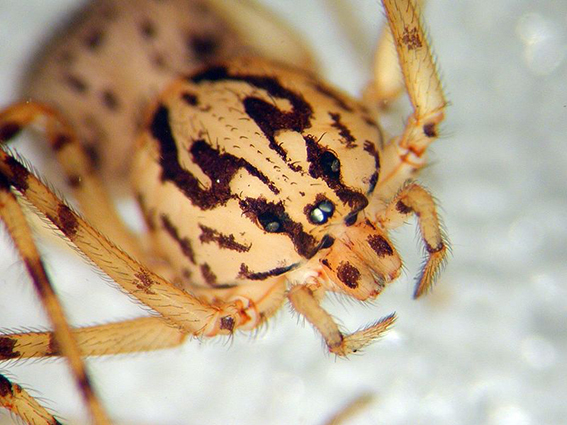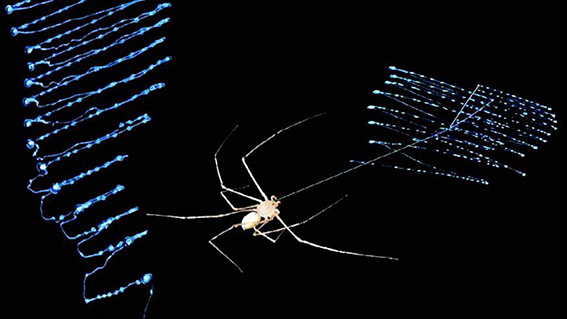With their impressive arsenal of traps, fangs, and immobilising venom, spiders are incredibly efficient killers, able to bring down prey much larger than themselves with lightning-fast reflexes.
But for some species it’s not enough to simply sit and wait for a fly to collide with their webs. Spitting spiders take a more aggressive approach, roaming their territory under the cover of darkness and firing sticky nets of silk to pin down unsuspecting victims.

Yep, these are real-life Spiderman tactics and that deadly liquid silk can travel at speeds of almost 30 metres per second.
Spitting spider: range, habitat, description
Spitting spiders belong to the family Scytodidae, which contains 239 species from every corner of the globe.
They tend to be more active at night, and gravitate towards the warm and cosy confines of caves or houses, keeping out of sight in dark crevices, closets, and under rocks during the day. The good news is they are not dangerous to humans.
The most common species, Scytodes thoracica, is found globally, and is identified by its bright orange colouring, with dark patterns on its legs and body. And while most spiders have eight eyes, spitting spiders have only six.

Most spitting spiders are tiny, and S. thoracica is no different - its body ranges from just 3 to 6 mm (0.12 to 0.24 in) long.
Spitting spiders have a distinctive ‘slow-walking’ behaviour, thanks to their long, slender legs. Their front two legs are the longest, and these play a crucial role in the spitting spider’s ‘track and lure’ predation.
Spitting spider hunting and defence
While some species of spitting spider build webs, most are prowling predators and follow a strict order of business: tapping, spitting, biting, wrapping, and feeding.
Once it’s located a potential meal (typically a small insect or spider), a spitting spider will begin slowly to inch towards it. It will then raise its two front legs and start tapping on and around its prey.
It does this because spitting spiders have relatively poor eyesight, so they use taps to manoeuvre themselves around their prey to assume the perfect striking position.
When ready, the spitting spider will raise its fangs and eject a sticky concoction of liquid silk, which congeals upon contact.

And we’re not just talking a messy blob of glue here – spitting spiders use alternating fangs to eject two zigzagging strands of silk, which overlap to form a neat and super-strong net that pins its prey in place.
The attack takes just 1/700th of a second to complete. The spider will then approach its prey and, if it looks like it’s going to break free, roll it up in the netting.
“It’s quite amazing what nature comes up with during the course of evolution, such as spiting silk onto prey to ‘nail' the prey down, which prevents its escape,” Dr Volker Herzig, who has been researching the spider’s venom at The University of Queensland’s Institute for Molecular Bioscience (IMB) in Australia, said.
After ensnaring its prey, the spitting spider will inject a dose of venom to paralyse it and then corrosive saliva to liquefy its insides. It will then suck this out through several bite holes in the body.
It also turns out this approach is a pretty great way to get out of trouble. Because, if faced with a predator such as a wolf spider, spitting spiders are too slow-moving to flee, they are more likely to stand their ground and spit in the hope of immobilising them.

Venomous silk spray
The spitting spider’s sticky liquid silk is produced inside its venom glands, which has led many to assume that the silk is laced with venom.
But some scientists have argued that we don’t have enough evidence to say that for sure and more research is needed.
Spitting spiders vs brown recluse
It’s easy to mistake a spitting spider for the far more dangerous brown recluse spider – they both have similar colouring, long, delicate legs, and six eyes instead of eight.
According to the University of California, Riverside, to tell the difference, you should check the legs – spitting spiders have two colours on their legs, while brown recluse spiders have just one. The same thing goes for the body.
Spitting spider a target for medical research
Researchers are currently investigating spider venom peptides – short chains of amino acids – as the potential basis for new types of medication that could treat a range of medical conditions from chronic pain and inflammation to cardiovascular disorders and erectile dysfunction.
It’s no easy task, as some spiders produce venom containing more than 1,000 unique peptides. Based on the number of known species in the world, that means we’re talking upwards of 12 million unique spider venom peptides that need to be studied.
But the early signs suggest that these peptides are worth the effort.
“The advantage of spider venom peptides is that they can be very potent and selective at the same time,” Dr Herzig explained.
“Selectivity helps in preventing unwanted side effects, and a high potency means that only very small quantities of these peptides have to be used.”
In 2016, Dr Herzig, his colleagues at IMB and the Lewis & Clark College in the US were the first to test the molecular activity of three spitting spider peptides.
He explains that spider venom peptides usually target ion channels in the nervous system, either activating or inhibiting them, and that means they could be useful for treating medical conditions that involve altered ion channel activity, such as autoimmune diseases, stroke, and chronic pain.
Of the three spitting spider peptides that have so far been tested, none has revealed any medically useful function – but there are at least another 47 known spitting spider peptides yet to be tested.
But for the time being they might have to take a backseat to tarantula venom peptides, which Dr Herzig says have shown amazing therapeutic potential in the past few years, and are relatively easy to extract.
“Most of the promising candidates come from tarantula venoms, but this is mainly due to the fact that the majority of spider venoms that are studied are sourced from tarantulas,” he said.
“Tarantulas are usually large spiders and therefore yield large amounts of venom (at least for a spider, but not in comparison to snakes, for example) and they are also easily available through the pet trade.”
“The venoms of the majority of other spider families are largely unstudied. So far, venoms from only about 100 spider species from 47,000 known species have been studied. And tarantula venom peptides make up 450 of 1,426 known spider venom peptides.”
Maybe one day the spitting spider will have its day in the sun when it comes to fighting pain, but until then, at least we have our real-life Spiderman.



